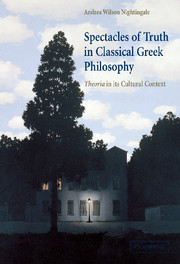Book contents
- Frontmatter
- Contents
- Acknowledgments
- Introduction
- 1 Theoria as a cultural practice
- 2 Inventing philosophic theoria
- 3 The fable of philosophy in Plato's Republic
- 4 Theorizing the beautiful body: from Plato to Philip of Opus
- 5 “Useless” knowledge: Aristotle's rethinking of theoria
- Epilogue: “Broken knowledge”? Theoria and wonder
- List of references
- Index of passages cited
- General index
4 - Theorizing the beautiful body: from Plato to Philip of Opus
Published online by Cambridge University Press: 22 September 2009
- Frontmatter
- Contents
- Acknowledgments
- Introduction
- 1 Theoria as a cultural practice
- 2 Inventing philosophic theoria
- 3 The fable of philosophy in Plato's Republic
- 4 Theorizing the beautiful body: from Plato to Philip of Opus
- 5 “Useless” knowledge: Aristotle's rethinking of theoria
- Epilogue: “Broken knowledge”? Theoria and wonder
- List of references
- Index of passages cited
- General index
Summary
Beauty is momentary in the mind –
The fitful tracing of a portal;
But in the flesh it is immortal.
Wallace StevensIt's not my fault that we are made so, half from disinterested contemplation, half from appetite./ If I should accede one day to Heaven, it must be there as it is here, except that I will be rid of my dull senses and my heavy bones./ Changed into pure seeing, I will absorb, as before, the proportions of human bodies, the color of irises, a Paris street in June at dawn,/ all of it incomprehensible, incomprehensible the multitude of visible things.
Czeslaw Milosz, trans. Robert HassPlato is famous for his denigration of the physical world. In the myths in the Phaedo and Phaedrus, however, and in the “likely account” in the Timaeus, Plato offers a very positive account of the physical cosmos as a whole and of certain (exceptional) bodies within it. In particular, he identifies certain bodies as perfect (or near-perfect) “images” of the Forms: they are not just shadowy eidola, but agalmata or “sacred images” of true reality. These bodies are either exceptionally beautiful bodies in the terrestrial realm or the heavenly bodies in the celestial sphere. Although Plato generally has a very negative view of the sensible world, he makes an exception in the case of physical beauty: beautiful bodies have a sort of sacred status which generates, for the philosopher, the kind of sacralized visualization that theoroi experience at religious festivals and sanctuaries.
- Type
- Chapter
- Information
- Spectacles of Truth in Classical Greek PhilosophyTheoria in its Cultural Context, pp. 139 - 186Publisher: Cambridge University PressPrint publication year: 2004

